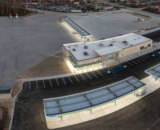The Federal Highway Administration on Friday August 21 released a survey and analysis assessing truck parking in the United States.
Although NATSO worked with FHWA to help the agency understand the issues involved in the supply and demand of truck parking facilities, FHWA’s survey did not adequately explore the critical factors that influence truck parking.
In “Jason’s Law Truck Parking Survey Results and Comparative Analysis,” FHWA reported that more than 75 percent of truck drivers and almost 66 percent of logistics personnel reported regularly experiencing problems with finding safe parking locations when rest was needed. The survey said that 90 percent reported struggling to find safe and available parking during night hours.
The 180-page survey and analysis, mandated by Congress, collected responses from state departments of transportation, more than 7,000 independent truck drivers and nearly 400 truckstops. FHWA intends to use the survey to promote a national dialogue between the government and industry stakeholders on truck parking availability nationwide.
FHWA’s analysis implied that the federal ban on rest area commercialization, “driven by competing interests of different private industries,” reduces the potential number of parking spaces available at rest areas. The report goes on to say, “Striking a balance between the needs of the trucking industry at public facilities and the interests of private retailers in maintaining viable travel centers has long been a challenge…”
Evidence indicates that not only would commercialization not increase parking, it would have the opposite effect. Though the analysis found that New England (an area saturated with commercialized roadways) has the fewest truck parking spaces, there was no discussion of the impact of commercialization on supply. A NATSO analysis found that roadways with commercial rest areas have 1/3 fewer spaces than roadways with the same truck traffic. Commercial rest areas thwart competition from truckstops and travel centers, reducing the number of these businesses and parking.
The analysis repeatedly references a lack of real-time parking information as a problem. However, state transportation departments supplied all of these observations, not truck drivers. The report cites the handful of states that are working on separate, federally-funded real-time parking information projects. It does not discuss the cost-effectiveness of these separate state initiatives, which so far have cost federal taxpayers $20 million.
Also notable is the absence of how trucking fleets work to ensure their drivers and trucks have safe, legal places to park.
Subscribe to Updates
NATSO provides a breadth of information created to strengthen travel plazas’ ability to meet the needs of the travelling public in an age of disruption. This includes knowledge filled blog posts, articles and publications. If you would like to receive a digest of blog post and articles directly in your inbox, please provide your name, email and the frequency of the updates you want to receive the email digest.

